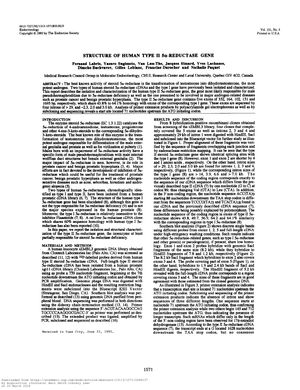Structure of Human Type II 5 Alpha-Reductase Gene
September 1992
in “
Endocrinology
”

TLDR The human type II 5α-reductase gene has a specific structure important for understanding certain medical conditions.
The document from 1992 detailed the isolation and characterization of the human type II 5α-reductase gene, which plays a role in conditions like male pseudohermaphroditism, prostate cancer, and benign prostatic hyperplasia. The gene was found to have five exons and four introns, with exon sizes ranging from 102 to 1695 base pairs and intron sizes exceeding 2.0 kilobases. There was a notable homology of 43.8% to 64.1% between the exons of this gene and those of the type I 5α-reductase gene. A transcription start site was located 71 nucleotides before the ATG initiating codon, and a single nucleotide difference was identified in the coding region, altering an amino acid from valine to leucine. Southern blot analysis confirmed the gene's structure and its low homology with other related genes. The study also provided insights into the gene's role in DHT formation and action in androgen target tissues, which could aid in the analysis of 5α-reductase deficiency and related endocrine disorders.


![Synthesis and In Vitro Study of 17β-[N-Ureylene-N,N′-Disubstituted]-4-Methyl-4-Aza-5α-Androstan-3-Ones as Selective Inhibitors of Type I 5α-Reductase](/images/research/d19df8a7-8de6-4430-8a0d-4ffa1f502985/small/15608.jpg)


